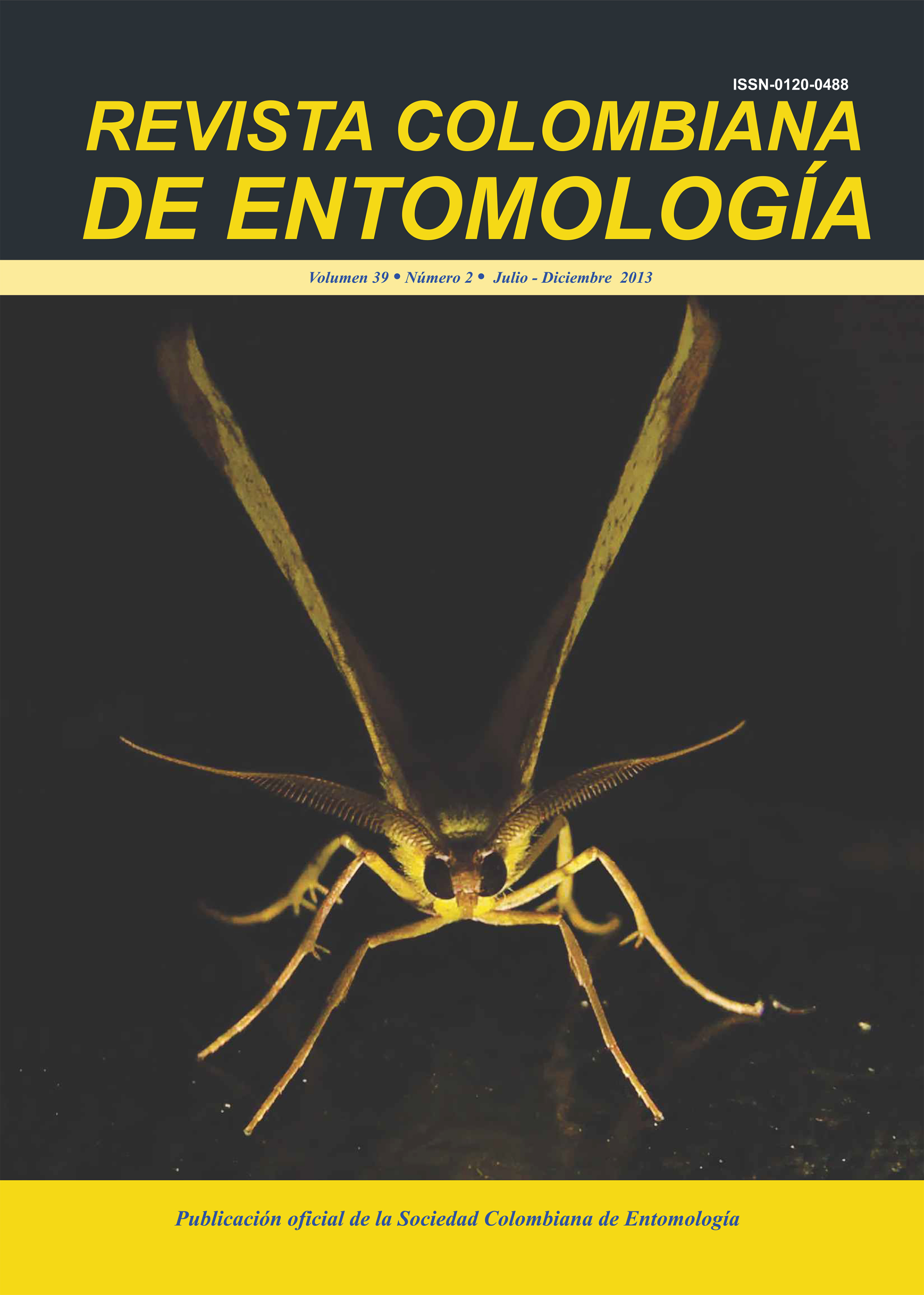Hemerobiidae (Neuroptera) in the midwestern region of Minas Gerais State, Brazil
Keywords:
Brown lacewing, Biodiversity, Taxonomy, NeotropicalMain Article Content
This study aimed to identify the Hemerobiidae (Neuroptera) associated to Brazilian savannah and gallery forest, in Minas Gerais State, Brazil. The sampling was carried every two weeks at Brazilian savannah (Cerrado) in Divinópolis and at gallery forest in Pedra do Indaiá, both in Minas Gerais State, Brazil. Collecting was carried out between November 2003 and October 2004, with Malaise traps. A total of 181 specimens of five species of Hemerobiidae were collected. The species Nusalala tessellata, Megalomus impudicus, Hemerobius bolivari and Notiobiella sp. were collected in the two sites; the fifth species Sympherobius sp. was found only in Pedra do Indaiá. The species of diversity (index of Shannon-Wiener) and the equitability (J) of Hemerobiidae were similar in the areas of Brazilian savannah and gallery forest (H’ = 0.47 - 0.49, respectively, and J = 0.78 - 0.69, respectively), and the differences observed between the two locations were not significant.
CHAGAS, E. F.; SILVEIRA NETO, S.; BRAZ, A. J. B. P.; MATEUS, C. P. B.; COELHO, I. P. 1982. Flutuação populacional de pragas e predadores em citros. Pesquisa Agropecuária Brasileir 17 (6): 817-824.
GONZÁLEZ-OLAZO, E. V. 1981. El género Megalomus Rambur (Neurop.-Planipennia-Hemerobiidae) en Argentina y Chile. Acta Zoológica Lilloana 36 (2): 97-113.
GONZÁLEZ-OLAZO, E. V. 1987. Los neurópteros asociados con los cultivos cítricos de la provincia de Tucumán y descripción de una nueva especie de Nomerobius (Hemerobiidae). CIRPON, Revista de Investigación 1-4 (1): 37-54.
HUGHES, R. G. 1986. Theories and models of species abundances.The American Naturalist 128: 879-899.
LARA, R. I. R.; FREITAS, S. 2002. Caracterização morfológica de adultos de Nusalala tessellata (Gerstaecker, 1888) (Neuroptera, Hemerobiidae). Revista Brasileira de Entomologia 46 (4): 523 530.
LARA, R. I. R.; FREITAS, S. 2003. Caracterização morfológica de espécies de Hemerobius Linnaeus, 1758 (Neuroptera, Hemerobiidae) associadas a cultivo de café (Coffea arabica L.), milho (Zea mays L.) e erva-mate (Ilex paraguariensis St. Hill.). Revista Brasileira de Entomologia 47 (3): 427-434.
LARA, R. I. R.; PERIOTO, N. W. 2003. Primeiro registro de ocorrência de Sympherobius miranda (Navás, 1920) (Neuroptera, Hemerobiidae) para o Brasil. Arquivos do Instituto Biológic 70 (4): 511-512.
LARA, R. I. R.; FREITAS, S.; PERIOTO, N. W.; PAZ, C. C. P 2008. Amostragem, diversidade e sazonalidade de Hemerobiidae (Neuroptera) em Coffea arabica L. cv Obatã (Rubiaceae). Revista Brasileira de Entomologia 52 (1): 117-123.
LARA, R. I. R.; PERIOTO, N. W.; FREITAS, S. 2010. Diversidade de hemerobiídeos (Neuroptera) e suas associações com presas em cafeeiros. Pesquisa Agropecuária Brasileira 45 (2): 115-123.
MAGURRAN, A. E. 1988. Ecological diversity and its measurements. Princeton University Press, Princeton, 179 p.
MONSERRAT, V. J. 1990. A systematic checklist of the Hemerobiidae of the world (Insecta: Neuroptera). 1990. pp. 215-262. In: Mansell, M. W.; Aspöck, H. (Eds.). Advances in Neuropterology. Proceedings of the Third International Symposium on Neuropterology, South African Department of Agricultural Development: Pretoria. [Symposium held in Berg en Dal, Kruger National Park, 1988.] No figures.
MONSERRAT, V. J. 1996. Revision del género Hemerobius de Latinoamérica (Neuroptera, Hemerobiidae). Fragmenta Entomológica 27 (2): 399-523.
MONSERRAT, V. J. 1997. Revisión del género Megalomus de Latinoamérica (Neuroptera, Hemerobiidae). Fragmenta Entomológica 29 (1): 123-206.
MONSERRAT, V. J. 2000. Revisión del género Nusalala (Neuroptera, Hemerobiidae). Fragmenta Entomologica 32 (1): 83-162.
MONSERRAT, V. J. 2003. Contribución al conocimiento de los hemeróbidos de Patagonia y Tierra del Fuego (Insecta, Neuroptera, Hemerobiidae). Graellsia 59 (1): 37-56.
OSWALD, J. D. 1988. A revision of the genus Sympherobius Banks (Neuroptera, Hemerobiidae) of America North of Mexico with a synonymical list of the world species. Journal of the New York Entomological Society 96 (4): 390-451.
OSWALD, J. D. 1993. Revision and cladistic analysis of the world genera of the family Hemerobiidae (Insecta: Neuroptera). Journal of the New York Entomological Society 101 (2): 143 299.
OSWALD, J. D. 2004. Review of the brown lacewing genus Biramus (Neuroptera: Hemerobiidae: Hemerobiinae), with the description of a new species from Costa Rica and Panama. Tijdschrift voor Entomologie 147 (1): 41-47.
PENNY, N. D.; MONSERRAT, V. J. 1983. Neuroptera of the Amazon basin Part 10-Hemerobiidae. Acta Amazônica 3 (5-6): 879 909.
RODRIGUES, W. C. 2005. DivEs Diversidade de espécies. Versão 2.0. Software e Guia do Usuário. Disponible en: http://www.ebras.bio.br/dives/index.asp [Review date: 10 October 2010].
SOUZA, B.; CIOCIOLA, A. I. 1997. Efeito de diferentes dietas sobre a fecundidade e longevidade de Nusalala uruguaya (Navás 1923) (Neuroptera: Hemerobiidae). Pesquisa Agropecuária Brasileira 32 (1): 27-32.
SOUZA, B.; MATIOLI, J. C.; CIOCIOLA, A. I. 1990. Biologia comparada de Nusalala uruguaya (Navás, 1923) (Neuroptera: Hemerobiidae) alimentada com diferentes espécies de afídeos. I. fase de larva. Anais da Escola Superior de Agricultura Luiz de Queiroz 47 (2): 283-300.
SZENTKIRÁLYI, F. 1989. Aphidophagous Crysopid and Hemerobiid (Neuropteroidea) subguilds in different maize fields: influence of vegetational diversity on sub guild structure. Acta Phytopathologica et Entomologica Hungarica 24: 207-211.
Downloads

This work is licensed under a Creative Commons Attribution-NonCommercial-ShareAlike 4.0 International License.
Authors retain the copyright on their work and are responsible for the ideas expressed in them. Once a manuscript is approved for publication, authors are asked for a publication license for the term of legal protection, for all territories that allows the use, dissemination and disclosure of the same.

